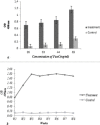Production of specific IgY antibody to the recombinant FanC protein produced in Escherichia coli
- PMID: 27746871
- PMCID: PMC5048125
Production of specific IgY antibody to the recombinant FanC protein produced in Escherichia coli
Abstract
Objectives: Enterotoxigenic Escherichia coli (ETEC) strains are one of the primary causes of diarrhea in newborn calves and in humans, pigs, and sheep. IgY technology has been identified as a promising alternative to generating a mass amount of specific antibody for use in immunotherapy and immunodiagnostics. The purpose of this study was to produce specific antibody by egg yolk antibody (IgY) to recombinant FanC protein from ETEC.
Materials and methods: FanC (K99) gene was amplified from ETEC by specific primers and polymerase chain reaction. The gene was cloned and subcloned into pTZ57R/T and pET32a (+) vectors, respectively. Recombinant vector was transferred into E. coli BL21 CodonPlus (DE3). Protein expression was investigated by 1 mM IPTG induction. Hens were immunized by the purified recombinant FanC protein. The activity and specificity of the IgY antibody were detected by dot-blotting, Western blotting, and indirect ELISA.
Results: We obtained FanC specific IgYs by immunizing the hens with the recombinant FanC protein. The anti-FanC IgY showed binding specifically to the FanC protein of ETEC.
Conclusion: The results emphasize that specific IgY against the recombinant FanC protein could be recommended as a candidate for passive immunization against ETEC infection in animals and humans.
Keywords: Enterotoxigenic Escherichia coli; IgY; Immunization; Recombinant protein.
Figures





Similar articles
-
Production and characterization of egg yolk antibody (IgY) against recombinant VP8-S2 antigen.Pol J Vet Sci. 2016;19(2):271-9. doi: 10.1515/pjvs-2016-0034. Pol J Vet Sci. 2016. PMID: 27487500
-
A Combination of Egg Yolk IgY and Phosvitin Inhibits the Growth of Enterotoxigenic Escherichia coli K88 and K99.Curr Pharm Biotechnol. 2017;18(5):400-409. doi: 10.2174/1389201018666170425120036. Curr Pharm Biotechnol. 2017. PMID: 28443510
-
Chicken egg yolk immunoglobulin (IgY) developed against fusion protein LTB-STa-STb neutralizes the toxicity of Escherichia coli heat-stable enterotoxins.J Appl Microbiol. 2014 Aug;117(2):320-8. doi: 10.1111/jam.12525. Epub 2014 May 14. J Appl Microbiol. 2014. PMID: 24750381
-
Strategies to overexpress enterotoxigenic Escherichia coli (ETEC) colonization factors for the construction of oral whole-cell inactivated ETEC vaccine candidates.Appl Microbiol Biotechnol. 2012 Mar;93(6):2291-300. doi: 10.1007/s00253-012-3930-6. Epub 2012 Feb 16. Appl Microbiol Biotechnol. 2012. PMID: 22350259 Review.
-
IgY technology: Methods for developing and evaluating avian immunoglobulins for the in vitro detection of biomolecules.World J Methodol. 2021 Sep 20;11(5):243-262. doi: 10.5662/wjm.v11.i5.243. eCollection 2021 Sep 20. World J Methodol. 2021. PMID: 34631482 Free PMC article. Review.
Cited by
-
IgYs: on her majesty's secret service.Front Immunol. 2023 Jun 12;14:1199427. doi: 10.3389/fimmu.2023.1199427. eCollection 2023. Front Immunol. 2023. PMID: 37377972 Free PMC article. Review.
-
The expression and construction of engineering Escherichia coli producing humanized AluY RNAs.Microb Cell Fact. 2017 Oct 30;16(1):183. doi: 10.1186/s12934-017-0800-z. Microb Cell Fact. 2017. PMID: 29084536 Free PMC article.
References
-
- Jay CM, Bhaskaran S, Rathore KS, Waghela SD. Enterotoxigenic K99 Escherichia coli attachment to host cell receptors inhibited by recombinant pili protein. Vet Microbiol. 2004;101:153–160. - PubMed
-
- Clarke SC. Diarrhoeagenic Escherichia coli an emerging problem? Diagn Microbiol Infect Dis. 2001;41:93–98. - PubMed
LinkOut - more resources
Full Text Sources
